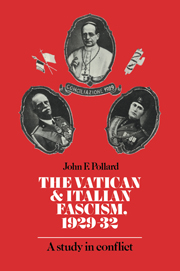Book contents
- Frontmatter
- Contents
- Acknowledgements
- Abbreviations
- 1 INTRODUCTION
- 2 THE ADVENT OF THE CONCILIAZIONE
- 3 REACTIONS TO THE CONCILIAZIONE AND THE RATIFICATION OF THE PACTS
- 4 THE DIPLOMATIC DIMENSION: ITALIAN FOREIGN POLICY AND THE VATICAN, 1929–31
- 5 THE CATHOLIC OFFENSIVE: CATHOLIC ACTION AND THE REGIME, 1929–31
- 6 THE CRISIS OF 1931
- 7 CONCLUSION AND EPILOGUE
- Appendix I The Law of Guarantees of 1871
- Appendix II The Lateran Pacts of 1929
- Appendix III The September Accords, 1931
- Appendix IV A note on archival and other sources
- Bibliography
- Index
3 - REACTIONS TO THE CONCILIAZIONE AND THE RATIFICATION OF THE PACTS
Published online by Cambridge University Press: 03 February 2010
- Frontmatter
- Contents
- Acknowledgements
- Abbreviations
- 1 INTRODUCTION
- 2 THE ADVENT OF THE CONCILIAZIONE
- 3 REACTIONS TO THE CONCILIAZIONE AND THE RATIFICATION OF THE PACTS
- 4 THE DIPLOMATIC DIMENSION: ITALIAN FOREIGN POLICY AND THE VATICAN, 1929–31
- 5 THE CATHOLIC OFFENSIVE: CATHOLIC ACTION AND THE REGIME, 1929–31
- 6 THE CRISIS OF 1931
- 7 CONCLUSION AND EPILOGUE
- Appendix I The Law of Guarantees of 1871
- Appendix II The Lateran Pacts of 1929
- Appendix III The September Accords, 1931
- Appendix IV A note on archival and other sources
- Bibliography
- Index
Summary
At the risk of stating the obvious, it needs to be said that the Conciliazione was an agreement reached at the highest levels of Church and State, the result of negotiations amongst a very few individuals at the highest level and conducted in the greatest of secrecy. On the Vatican side no more than half a dozen men were involved, led by Cardinal Gasparri – with the Pope himself frequently intervening. The number of those involved in the negotiations, or at least kept informed of them on the Italian side, was probably much the same – Mussolini, Rocco, Mattei-Gentili, Barone – and in the background, the King. For Mussolini, direct involvement in and responsibility for the negotiations ensured that it would be acclaimed as his achievement, and his alone. It was essential to prevent interference from the more anti-clerical elements of Fascism, like Balbo or Farinacci. It seems extremely unlikely that they would have allowed Mussolini to make the concessions which he actually did make on issues like marriage and Catholic Action; only by presenting them as a fait accompli, and by staking his authority on them could he hope to win acceptance for them from the Fascist Party.
Despite the increasing number of leaks of information in official circles as the negotiations neared their end in January and February 1929, the signing of the Lateran Pacts inevitably came as a complete surprise to the overwhelming majority of the Italian population.
- Type
- Chapter
- Information
- The Vatican and Italian Fascism, 1929–32A Study in Conflict, pp. 48 - 74Publisher: Cambridge University PressPrint publication year: 1985

